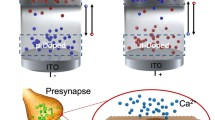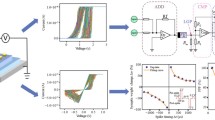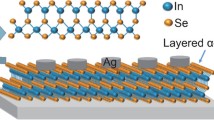Abstract
Memristors have received widespread attention as a new type of nonvolatile memory device, which are promising to mimic synapse dynamics efficiently. In this work, a memristor with the structure of PMMA/Ag/FAPbI3/FTO was fabricated and memristive behavior was investigated. With PMMA as the passivation layer in this structure, the performance as well as stability of the FAPbI3 memristor was significantly improved, as compared with non-passivated device. The results show that the device with passivation layer has better stability in the air (20 days) and excellent artificial synaptic functions, such as spike timing-dependent plasticity (STDP), long-term potentiation (LTP) and long-term depression (LTD). This work demonstrates the great potential of PMMA-passivated perovskite memristor in neuromorphic computing.






Similar content being viewed by others
Data availability
The data can be provided by the authors upon reasonable request.
References
M. Davies et al., Loihi: a neuromorphic many core processor with on-chip learning. IEEE Micro 38(1), 82–99 (2018)
J.-W. Jang, S. Park, G.W. Burr, H. Hwang, Y.-H. Jeong, Optimization of conductance change in Pr1–xCaxMnO3-based synaptic devices for neuromorphic systems. IEEE Electron Device Lett. 36(5), 457–459 (2015)
G. Snider, R. Amerson, D. Carter, H. Abdalla, M.S. Qureshi, J. Léveillé, M. Versace, H. Ames, S. Patrick, B. Chandler, A. Gorchetchnikov, From synapses to circuitry: using memristive memory to explore the electronic brain. J. Comput. 44(2), 21–28 (2011)
G. Indiveri, B. Linares-Barranco, R. Legenstein, G. Deligeorgis, T. Prodromakis, Integration of nanoscale memristor synapses in neuromorphic computing architectures. Nanotechnology 24(38), 384010 (2013)
Y.V. Pershin, M. Di Ventra, Memcapacitive neural networks. Electronics Lett. 50(3), 141–143 (2014)
B.C. Jang et al., Polymer analog memristive synapse with atomic-scale conductive filament for flexible neuromorphic computing system. Nano Lett. 19(2), 839–849 (2019)
D. Kuzum, S. Yu, H.S. PhilipWong, Synaptic electronics: materials, devices and applications. Nanotechnology 24(38), 382001 (2013)
A.N. Matsukatova et al., Scalable nanocomposite parylene-based memristors: multifilamentary resistive switching and neuromorphic applications. Nano Res. 16, 3207–3214 (2022)
D.B. Strukov, G.S. Snider, D.R. Stewart, R.S. Williams, The missing memristor found. Nature 453(7191), 80–83 (2008)
Q. Huo et al., A computing-in-memory macro based on three-dimensional resistive random-access memory. Nat. Electron. 5(7), 469–477 (2022)
Q. Liu, S. Gao, L. Xu et al., Nanostructured perovskites for nonvolatile memory devices. Chem. Soc. Rev. 51, 3341–3379 (2022)
K. Qian, G. Cai, V.C. Nguyen, T. Chen, P.S. Lee, Direct observation of conducting filaments in tungsten oxide based transparent resistive switching memory. ACS Appl Mater Interfaces 8(41), 27885–27891 (2016)
J. Hou, S.S. Nonnenmann, W. Qin, D.A. Bonnel, Size dependence of resistive switching at nanoscale metal-oxide interfaces. Adv. Funct. Mater. 24(26), 4113–4118 (2014)
Z. Xiao, J. Huang, Energy-efficient hybrid perovskite memristors and synaptic devices. Adv. Electron. Mater. 2(7), 1600100 (2016)
W.-J. Yin, T. Shi, Y. Yan, Unusual defect physics in CH3NH3PbI3 perovskite solar cell absorber. Appl. Phys. Lett. 104(6), 063903 (2014)
H.-S. Kim et al., Lead Iodide perovskite sensitized all-solid-state submicron thin film mesoscopic solar cell with efficiency exceeding 9%. Sci. Rep. 2(1), 591 (2012)
Y. Lv et al., High performance perovskite solar cells using TiO2 nanospindles as ultrathin mesoporous layer. J. Energy Chem. 27(4), 951–956 (2018)
S.D. Stranks, H.J. Snaith, Metal-halide perovskites for photovoltaic and light-emitting devices. Nat. Nanotechnol. 10(5), 391–402 (2015)
H. Cho et al., Overcoming the electroluminescence efficiency limitations of perovskite light-emitting diodes. Science 350(6265), 1222 (2015)
E.J. Yoo, M. Lyu, J.H. Yun, C.J. Kang, Y.J. Choi, L. Wang, Resistive switching behavior in organic-inorganic Hybrid CH3NH3PbI3-xClx perovskite for resistive random access memory devices. Adv Mater 27(40), 6170–6175 (2015)
Y. Fang, S. Zhai, L. Chu, J. Zhong, Advances in halide perovskite memristor from lead-based to lead-free materials. ACS Appl Mater Interfaces 13(15), 17141–17157 (2021)
Y. Sun et al., Competition between metallic and vacancy defect conductive filaments in a CH3NH3PbI3-based memory device. J. Phys. Chem. C 122(11), 6431–6436 (2018)
K. Yan et al., a High-performance perovskite memristor based on methyl ammonium lead halides. J. Mater. Chem. C 4(7), 1375–1381 (2016)
G.E. Eperon, S.D. Stranks, C. Menelaou, M.B. Johnston, L.M. Herz, H.J. Snaith, Formamidinium lead trihalide: a broadly tunable perovskite for efficient planar heterojunction solar cells. Energy Environ. Sci. 7(3), 982 (2014)
T.M. Koh et al., Formamidinium-containing metal-halide: an alternative material for near-IR absorption perovskite solar cells. J. Phys. Chem. C 118(30), 16458–16462 (2013)
N. Pellet et al., Mixed-organic-cation perovskite photovoltaics for enhanced solar-light harvesting. Angew Chem Int Ed Engl 53(12), 3151–3157 (2014)
F. Zhou et al., Perovskite photovoltachromic supercapacitor with all-transparent electrodes. ACS Nano 10(6), 5900–5908 (2016)
J.S. Yun et al., Humidity-induced degradation via grain boundaries of HC(NH2)2PbI3 planar perovskite solar cells. Adv. Funct. Mater. 28(11), 1705363 (2018)
G. Divitini, S. Cacovich, F. Matteocci, L. Cinà, A. Di Carlo, C. Ducati, In situ observation of heat-induced degradation of perovskite solar cells. Nat. Energy 1(2), 1–6 (2016)
P. Zhang, M. Xia, F. Zhuge, Y. Zhou, Z. Wang, B. Dong, Y. Fu, K. Yang, Y. Li, Y. He, R.H. Scheicher, X.S. Miao, Nanochannel-based transport in an interfacial memristor can emulate the analog weight modulation of synapses. Nano Lett. 19(7), 4279–4286 (2019)
E. Yoo, M. Lyu, J.-H. Yun, C. Kang, Y. Choi, L. Wang, Bifunctional resistive switching behavior in an organolead halide perovskite based Ag/CH3NH3PbI3−xClx/FTO structure. J. Mater. Chem. C 4(33), 7824–7830 (2016)
M. Kund et al., In Conductive bridging RAM (CBRAM): an emerging non-volatile memory technology scalable to sub 20nm, IEEE International Electron Devices Meeting 2005.
R. Waser, M.J.N.M. Aono, Nanoionics-based resistive switching memories. Nat. Mater. 6, 833–840 (2007)
S.H. Jo, W.J.N.L. Lu, CMOS compatible nanoscale nonvolatile resistance switching memory. Nano Lett. 8(2), 392–397 (2008)
S.H. Jo, K.H. Kim, W.J.N.L. Lu, Programmable resistance switching in nanoscale two-terminal devices. Nano Lett. 9(1), 496–500 (2009)
J.J. Yang, M.D. Pickett, X. Li, D.A. Ohlberg, D.R. Stewart, R.S. Williams, Memristive switching mechanism for metal/oxide/metal nanodevices. Nat Nanotechnol 3(7), 429–433 (2008)
S. Yu, Neuro-inspired computing with emerging nonvolatile memorys. Proc IEEE Inst Electr Electron Eng 106(2), 260–285 (2018)
D.O. Hebb, The Organization of Behavior A Neuropsychological Theory (Chapman & Hall, London, 2013)
S. Song, Competitive Hebbian learning through spike timing-dependent plasticity (STDP). Brandeis University (2002)
G.Q. Bi, M.M.J. Poo, Synaptic modifications in cultured hippocampal neurons: dependence on spike timing, synaptic strength, and postsynaptic cell type. J. Neurosci. 18(24), 10464–10472 (2012)
C. Du, W. Ma, T. Chang, P. Sheridan, W.D. Lu, Biorealistic implementation of synaptic functions with oxide memristors through internal ionic dynamics. Adv. Funct. Mater. 25(27), 4290–4299 (2015)
J.S. Han et al., Air-stable cesium lead iodide perovskite for ultra-low operating voltage resistive switching. Adv. Funct. Mater. 28(5), 1705783 (2018)
S. Ge et al., Silver iodide induced resistive switching in CsPbI3 perovskite-based memory device. Adv. Mater. Interfaces 6(7), 1802071 (2019)
J.D. Luo et al., Phase-dependent memristive behaviors in FAPbI3-based memristors. Mater. Today Commun. 33, 104186 (2022)
A.N. Matsukatova, A.V. Emelyanov, A.A. Minnekhanov, A.A. Nesmelov, A.Y. Vdovichenko, S.N. Chvalun, V.V. Rylkov, P.A. Forsh, V.A. Demin, P.K. Kashkarov, M.V. Kovalchuk, Resistive switching kinetics and second-order effects in parylene-based memristors. Appl. Phys. Lett. 117(24), 243501 (2020)
M. Prezioso, F. Merrikh Bayat, B. Hoskins, K. Likharev, D. Strukov, Self-adaptive spike-time-dependent plasticity of metal-oxide memristors. Sci. Rep. 6, 21331 (2016)
Author information
Authors and Affiliations
Corresponding author
Ethics declarations
Conflict of interests
The authors declare that they have no conflict of interest.
Additional information
Publisher's Note
Springer Nature remains neutral with regard to jurisdictional claims in published maps and institutional affiliations.
Rights and permissions
Springer Nature or its licensor (e.g. a society or other partner) holds exclusive rights to this article under a publishing agreement with the author(s) or other rightsholder(s); author self-archiving of the accepted manuscript version of this article is solely governed by the terms of such publishing agreement and applicable law.
About this article
Cite this article
Wu, Y., Huang, H., Xu, C. et al. The FAPbI3 perovskite memristor with a PMMA passivation layer as an artificial synapse. Appl. Phys. A 129, 364 (2023). https://doi.org/10.1007/s00339-023-06632-y
Received:
Accepted:
Published:
DOI: https://doi.org/10.1007/s00339-023-06632-y




